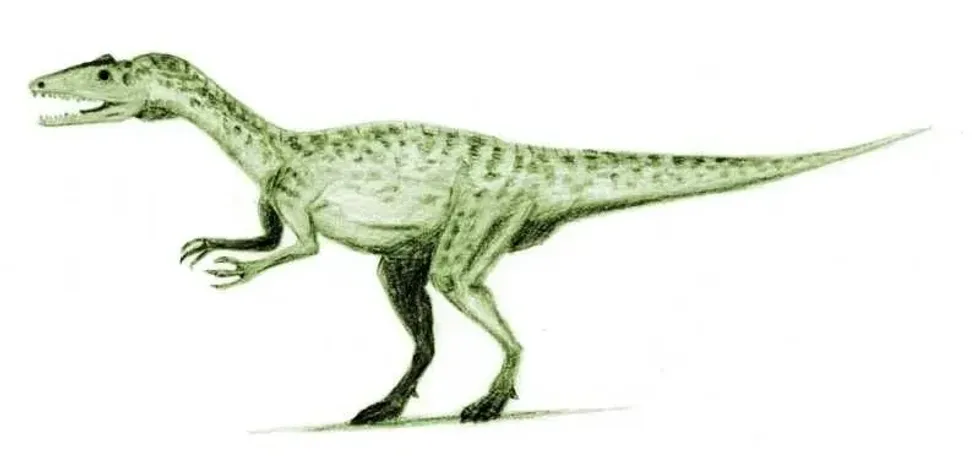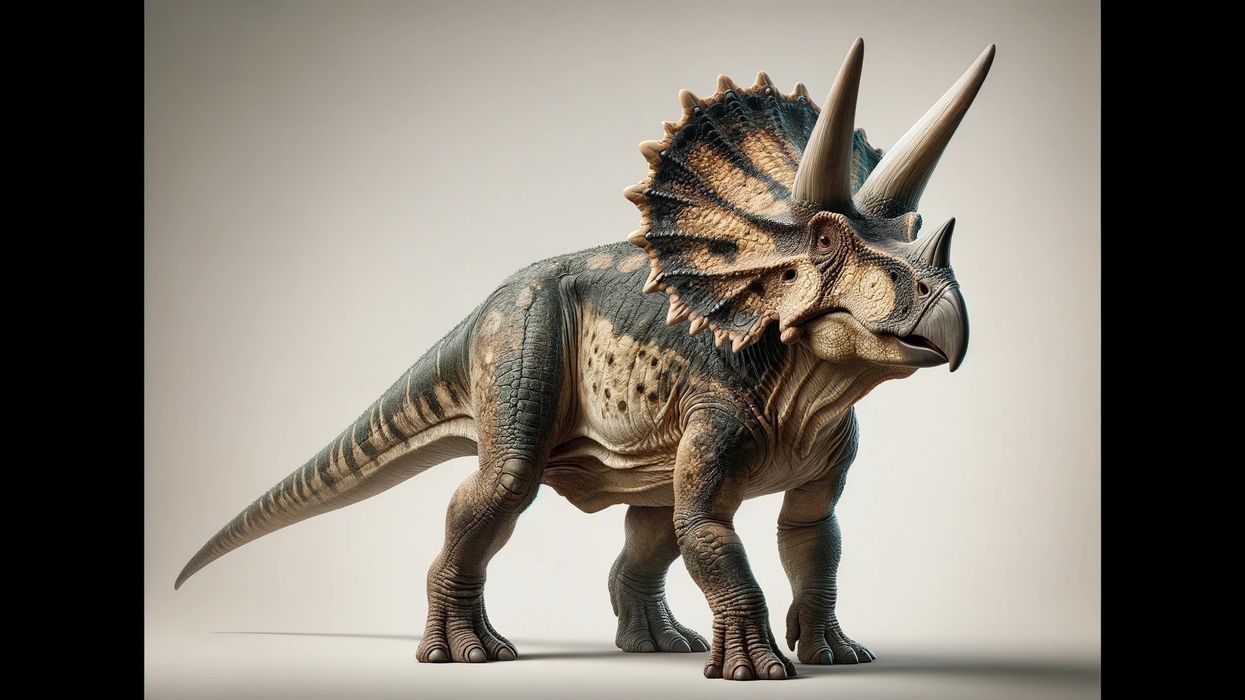The Lophostropheus is an extinct dinosaur genus that existed about 205.6 to 196.5 million years ago. This theropod dinosaur was a coelophysoid that roamed the Earth between the Rhaetian stage (Late Triassic Period) until the Hettangian stage (Early Jurassic Period).
The entire skeletal remains were not recovered. However, remains of the Lophostropheus skull, vertebrae from different parts, and even parts of the pelvic structure of this dinosaur were recovered from Normandy, France.
Some say that this dinosaur was roughly around 10 ft (3 m) long, while others suggest it might have been taller, being about 17 ft (5.2 m) long! There is an extra pair of cavities in the neck vertebrae.
Earlier, the classification of this member of the Theropoda clade was made in the Liliensternus genus, thus being named as Liliensternus airelensis. Another incorrect classification was also made when this species was declared as a Halticosaurus by Claude Larsonneur and Albert-Félix de Lapparent.
It was in the year 2007 when Gilles Cuny and Martin Ezcurra analyzed the remains and classified them in a new genus - the Lophostropheus.
Lophostropheus Interesting Facts
How do you pronounce 'Lophostropheus'?
The name of this dinosaur is pronounced 'LOAF-oh-STRO-fee-us'.
What type of dinosaur was a Lophostropheus?
The Lophostropheus was a coelophysoid theropod dinosaur.
In which geological period did the Lophostropheus roam the Earth?
This dinosaur roamed the Earth between the Late Triassic Period and the Early Jurassic Period.
When did the Lophostropheus become extinct?
This coelophysoid theropod dinosaur existed between the Triassic-Jurassic boundary, with the time period being between 205.6 to 196.5 million years ago.
Where did a Lophostropheus live?
It is said that Lophostropheus airelensis lived in modern-day Normandy, France.
What was a Lophostropheus's habitat?
This dinosaur lived in terrestrial habitats.
Who did a Lophostropheus live with?
Sorry, we are not aware of who the Lophostropheus lived with.
How long did a Lophostropheus live?
We are not aware of the lifespan of the Lophostropheus airelensis.
How did they reproduce?
Unfortunately, there is not much information available on their reproductive methods from the research done on the Liliensternus airelensis.
Lophostropheus Fun Facts
What did a Lophostropheus look like?
These theropods are considered to have a small to medium size anatomy which is of a moderate build.
The Lophostropheus dinosaurs differ from their fellow theropods in many ways. There are many features that resemble the derived theropods. Some of these features include having a ball socket connection to the front of their neck vertebrae, a vertical ridge on the dinosaurs’ ilium, and even a socket connection towards the front of their tail vertebrae.
However, these noticeable features have been taken into consideration as ‘convergences’ or 'differences'.
The Lophostropheus airelensis from the Triassic-Jurassic boundary has also been observed with pronounced crests placed at the tops as well as the bottoms of their neck vertebrae, thus giving it the genus name. Unlike the Liliensternus members (where it was formerly placed), this species had an extra pair of cavities in their neck vertebrae.
Rather than having connections to the Liliensternus group, they are much closer to the coelophysids such as the Coelophysis, hence being assigned to the Coelophysoidea superfamily.
As per the discovery and research made by Martin Ezcurra and Cuny in the year 2007, some features which can be used to distinguish Lophostropheus are :
As observed in Herrerasaurus, the last dorsal vertebral centrum of the Lophostropheus has a large, oval lateral fossa.
Like the Ceratosauria and Tetanurae, there is an incipient concavity at the cranial articular surface of this theropod’s cranial-caudal vertebrae. Also, the anterior postaxial cervical vertebrae have a slightly convex anterior articular surface.
The last dorsal vertebra on the skeleton has a dorsoventrally extended hyposphene.
Martin Ezcurra and Cuny also observed the similarity between this dinosaur and the Dilophosaurus in terms of the constant length of the skeleton’s caudal vertebrae along the tail length.
*We've been unable to source an image of Lophostropheus and have used an image of a Vespersaurus instead. If you are able to provide us with a royalty-free image of Lophostropheus, we would be happy to credit you. Please contact us at hello@kidadl.com.
How many bones did a Lophostropheus have?
The exact number of bones Lophostropheus had is not known.
How did they communicate?
Scientists aren't exactly sure how this species of dinosaur would have communicated with one another.
How big was a Lophostropheus?
This dino was a bipedal carnivore that grew to a length of about 9.8 ft (3 m).
However, later estimates stated by Molina-Pérez and Larramendi said that these theropods grew up to 17 ft (5.18 m) long.
With the new length in consideration, the Lophostropheus is about nine times the size of the Aquilops.
How fast could a Lophostropheus move?
We do not know how fast the Lophostropheus could move.
How much did a Lophostropheus weigh?
Rough estimates state that these dinosaurs of the Triassic-Jurassic time period weighed about 220 lb (100 kg).
In the year 2016, Larramendi and Molina-Pérez delivered higher estimates of the weight of these theropods, stating it to be about 300 lb (136 kg).
What were the male and female names of the species?
There are no separate names for the male and female specimens.
What would you call a baby Lophostropheus?
Baby dinosaurs are called hatchlings.
What did they eat?
This specimen was a bipedal carnivore, so it would have preyed upon other dinosaurs and animals of the period. However, exact information on the diet of this species is unknown.
How aggressive were they?
It is unknown exactly how aggressive these dinosaurs were.
Did you know...
The Lophostropheus airelensis was incorrectly classified as a member of the Halticosaurus and Liliensternus genera. However, in 2007 this species was recognized as a separate new gun and hence assigned as a Lophostropheus.
This theropod genus, Lophostropheus, was first described as well as named in the year 2007 by Martin Ezcurra, an Argentinian paleontologist (Bernardino Rivadavia Museum of Natural Science (Museo de Ciencias Naturales Bernardino Rivadavia)) and Gilles Cuny, a French paleontologist of the Université Pierre et Marie Curie. The type specimen under this genus is Lophostropheus airelensis.
The estimates made on this specimen's size were based entirely on the partial skeleton that was first described back in the year 1996 as a species belonging to Halticosaurus.
Baron, Barrett, and Norman conducted analyses of early dinosaurs in the year 2017 and placed the Lophostropheus dinosaur in a closer position to other derived theropods such as the Cryolophosaurus and the Sinosaurus.
The discovery spiraled into a reinterpretation in the year 1993 by Peter Galton and Gilles Cuny, who declared this dinosaur was a new species. Peter Galton and Gilles claimed and assigned this species to the Liliensternus group, and titled Liliensternus airelensis.
The saga continued, and other researchers began identifying differences between Liliensternus airelensis and Liliensternus liliensterni.
It was finally in 2007 when Gilles Cuny and Martin Ezcurra assigned a new genus, Lophostropheus. Not much is known about their hunting strategies.
Some other prominent dinosaurs found in France are Struthiosaurus, Compsognathus, and Telmatosaurus.
How did the Lophostropheus get its name?
This specimen of the Theropoda clade has an interesting story behind its name. The composite term Lophostropheus comes from a combination of Ancient Greek words. The term 'lophè' (λόφη) translates from Greek to ‘crest’, and 'stropheus' (στροφεύς) translates to ‘related to the vertebrae’, thus meaning ‘crest vertebrae’.
This name gives reference to these theropods' prominent dorsal and even ventral laminae which are observed in the dinosaur’s cranial cervical vertebrae.
The specific name, ‘airelensis’, is a reference to the region where this species was discovered - at the Airel Quarry. This quarry is located in a Rhaetian/Hettangian marginal marine limestone/claystone region around the Moon-Airel Formation of France.
What's unique about the Lophostropheus?
This dinosaur is one among the only ones from the Theropoda clan to have survived and lived in the Triassic-Jurassic extinction, even when half of the other species were wiped off the earth's surface.
The remains of Lophostropheus airelensis were received from the Airel Quarry region of the Moon-Airel Formation, which is in Basse-Normandie, France.
The remains of this specimen were collected in the year 1959 by Pareyn in sandy claystone and limestone. They were deposited on the boundary of the earlier Rhaetian stage which occurred in the Triassic period, and the Hettangian stage which occurred in the early Jurassic period.
Second image by Hypnoflow








